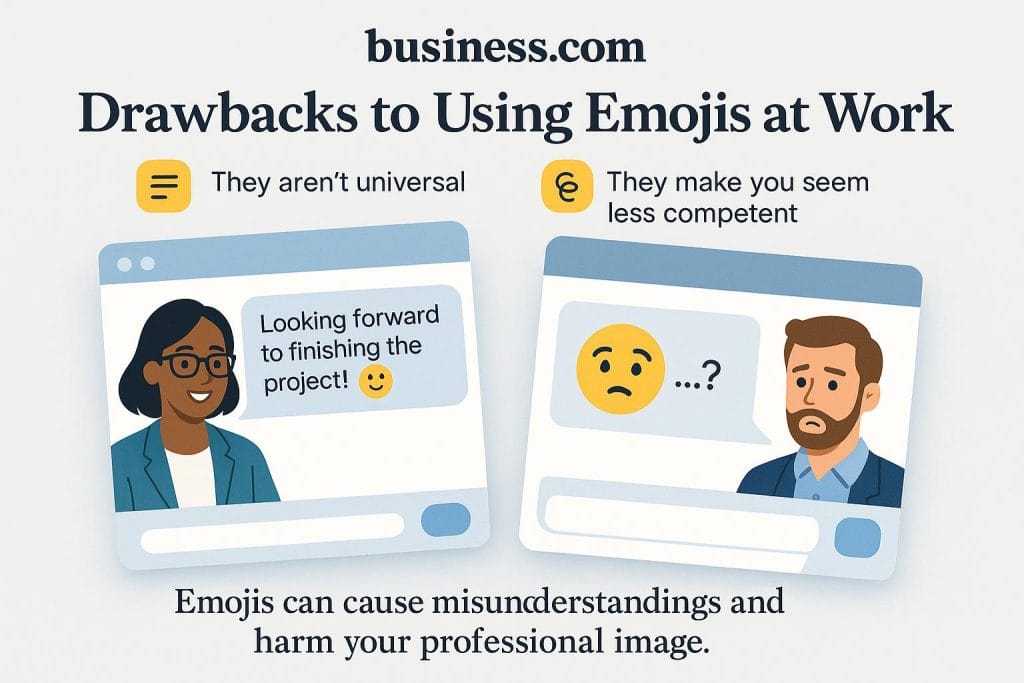Business.com aims to help business owners make informed decisions to support and grow their companies. We research and recommend products and services suitable for various business types, investing thousands of hours each year in this process.
As a business, we need to generate revenue to sustain our content. We have financial relationships with some companies we cover, earning commissions when readers purchase from our partners or share information about their needs. These relationships do not dictate our advice and recommendations. Our editorial team independently evaluates and recommends products and services based on their research and expertise. Learn more about our process and partners here.
Emojis at Work: Should You Use Emojis in Business Communications?
When using emojis in business communications, consider the channel, work environment and recipient.

Table of Contents
A picture is worth a thousand words — and an emoji can often save you just as many characters. They can also often convey tone and emphasis in ways that plain text can’t and help make a message feel more personal.
While emojis have become commonplace in text message marketing campaigns and on social media, whether they should be used in business communications — and how to use them effectively — is still something to consider. Here’s what you need to know about using emojis at work and best practices for doing so.
What are emojis?

Emojis are cartoon-like characters based on symbols from Japanese comics designed to express emotion through digital communication. Emojis are informal, personable and often used to inject humor into digital conversation. They can help convey a reaction when you’re emailing, texting or messaging someone who can’t see your body language. In a business setting, emojis may help break down barriers in formal communication and bring conversations to a more personal level. However, they’re not always advisable or appropriate.
Benefits of using emojis at work
Under the right circumstances, emojis can help your message better connect with your intended recipient. Some positives of using emojis in business communication include the following.
1. Emojis add a personal touch.
Communication that is too formal or stiff might be off-putting to some customers, vendors, co-workers and other people you do business with. Using emojis to express emotion and friendliness may appeal to their human side and help you better connect with them, build a sense of community and create a more positive atmosphere.
In particular, friendly communication using emojis can help you sustain and grow customer relationships and build on existing relationships with other contacts and stakeholders.
2. Emojis can create a sense of honesty.
Emojis are typically regarded as honest expressions of emotion. Genuine reactions of happiness, frustration, laughter and more can help you connect with recipients in a business setting and even reveal vulnerability.
Honesty and trust are appealing when you’re doing business with a brand, and the right emojis can convey genuine emotion and reactions. Used thoughtfully, emojis can even help you connect emotionally with customers by expressing relatable feelings. Sometimes, an honest reaction can win someone to your side or highlight shared feelings and viewpoints, deepening the connection.
3. Emojis get the reader’s attention.

Emojis are undoubtedly eye-catching and can instantly draw in a reader. They inject spirit into your communications and can even make someone more likely to engage with your message. In fact, according to Atlassian’s 2024 Teamwork Lab survey, 78 percent of respondents said they’d be more likely to read a message or open an email if it included an emoji.
4. Emojis can save you time.
When used right, emojis can say a lot with just one character. They’re quicker than typing out a full sentence and can help streamline your daily communication. If you’re constantly emailing, texting or messaging, emojis can shave seconds off each exchange, which can add up fast. Just make sure your recipient is in on the shorthand, so nothing gets lost in translation.
5. Emojis support accessibility and inclusion.
As a universal visual language, emojis can help fill the gap and reduce miscommunication. If you frequently deal with language barriers, emojis can help neutralize tone and meaning, ensuring everyone is on the same page. You can also use emojis to recognize different genders and skin tones, support neurodiversity, and promote cultural sensitivity.
Drawbacks to using emojis at work

Most messaging apps and platforms support emoji usage. However, just because they’re available doesn’t mean you should use them. Here are some caveats to consider when using emojis in a business environment.
1. Emojis aren’t universal.
Even if a certain emoji seems appropriate in a given situation, it may not always work as intended. According to Andrea Lehr, a brand relationship strategist at Fractl, there is no universal agreement on what specific emojis represent.
“Individuals bring their own personal experience to how they interpret an emoji, so although you might use an emoji with streaming tears after something you found incredibly funny, someone else might wonder why you’re upset,” Lehr explained.
“Emojis can get lost in translation,” cautioned Marty Estelle Lundstrom, founder of Polished Professionals and co-founder and vice president of Manners Pro. “While a red-faced emoji might mean ‘angry’ to one person, another person might interpret it as ’embarrassed.'” This can cause confusion and a disconnect between correspondents.
2. Emoji usage may be perceived as unprofessional.
Not everyone will greet your emojis with enthusiasm. Some recipients might have preconceived biases that equate emojis with unprofessionalism or even a perceived lack of competence — perceptions that can derail a business relationship before it’s even begun.
“Emojis are a newer form of communication, so if your recipient is [less familiar with digital communication], an emoji can make you seem less competent simply because your recipient was expecting a more traditional correspondence,” added Lehr.
3. Emojis may not be permissible in some workplaces.
Industries with regulatory requirements — such as healthcare, law or finance — may have restrictions on the use of emojis in communication. In highly regulated fields, using emojis can create confusion when you’re trying to explain something in detail or convey a sense of urgency.
Best practices for using emojis at work
Despite the concerns, many professionals still use emojis, partly because tech-savvy millennials make up a large percentage of the workforce, and also because of the widespread adoption of internal communication apps that promote casual work interactions.
Keep the following advice in mind when using emojis at work:
Context is important.

Context is a significant indicator of whether you should use emojis at work. If your workplace is informal, emojis are likely more acceptable, particularly if your co-workers use them frequently.
“Mirroring is a proven strategy for in-person communication, and I believe the same is true online,” said Hillary Hafke, corporate communications manager at Tinder. “Emojis are appropriate for some business emails in the same way that jokes are OK in some job interviews. You simply need to know your audience.”
Common sense is also an important element of context. For example:
- Don’t use emojis with people you don’t know very well.
- Be careful with emoji usage when messaging your boss.
- Be cautious with emojis when communicating with customers.
- If you don’t have a comfortable relationship with someone, avoid anything that could potentially turn them away — including emojis.
- Don’t use emojis if you’re responding to a serious complaint or issue.
“If you are creating a professional business email for a new client or business contact that you haven’t met personally yet, I would shy away from the use of emojis in any sort of correspondence with them,” advised James McCarthy, CEO of Placement Labs. “However, if the email recipient is a co-worker, employee or a client with whom you have a friendly, conversational relationship, then you should be able to use as many emojis as you would like.”
Above all, don’t use one if you aren’t certain what it means, and never replace a word with an emoji, cautioned Seamas Egan, founder and CEO of tinyCo.
“Work life without emojis sounds boring to me, but I also understand that there are moments where they are not necessary,” McCarthy added.
Know your audience.
Before using emojis, make sure you consider your audience’s communication preferences. Comfort with emojis can vary based on factors like workplace culture, industry norms and individual familiarity with digital communication tools. While some people may not understand certain emojis or feel they’re unprofessional, others — including many older professionals — embrace them as a natural part of modern messaging.
“If you’re sending an email to a supervisor, executive or client or work in a corporate environment, emojis may not be appropriate,” said Egan. “But for millennials and younger colleagues or in a startup work environment, emojis may be more popular and acceptable.”
Use emojis to support emotional check-ins.
Emojis can be a lightweight way to gauge how employees are feeling, especially if you have a remote work plan or hybrid teams. Team members might use emojis to update their status or “react” to messages, offering quick insight into their mood or mindset. You can even encourage people to choose an emoji that sums up their week.
Use emojis to reflect your company’s emotional culture.
A strong company culture keeps employees engaged and motivated — and emojis can help reinforce that culture when used authentically. Whether you’re highlighting core values or encouraging lightheartedness, emojis can support the tone your team embraces.
That said, don’t force a specific atmosphere through emoji use. Instead, define the emotional culture you want to foster, then consider how emojis can naturally complement and enhance it.
Create custom emojis for clarity and consistency.
Emojis don’t always mean the same thing to everyone. There may be different interpretations across age groups, cultures or even teams. For example, a simple smiley face might seem friendly to one co-worker but come across as passive-aggressive to another, depending on the context.
To avoid emoji-based miscommunications, consider developing a set of custom emojis tailored to your workplace. You’ll create a type of shared visual language that can help standardize tone, reduce confusion and make internal messaging more consistent and efficient.
How do businesses use emojis?
Here are a few examples of popular business uses for emojis.
Marketing
Emojis are often used in marketing campaigns targeting millennials and younger consumers. A simple smiley face can be a great way to grab someone’s attention. However, don’t just throw random emojis at your audience without a plan. If you’re going to use one, know what it means and use it appropriately.
Also, ensure any emojis you include are relevant to the content and aligned with your company’s online brand. If they’re not, your text messaging or email marketing campaigns could fall flat or feel disingenuous.
Communications
Emoji usage is most common in communication with clients, vendors, co-workers and others. When used thoughtfully, emojis can add emotional context and help create richer, more meaningful conversations by clarifying tone and expression. This can prevent the recipient from misinterpreting your message negatively.
Here are a few best practices for using emojis in formal conversations:
- Less is more. Use emojis sparingly in emails.
- Wait and observe. Don’t use emojis in email conversations until you’ve identified your recipient’s communication style.
- Follow their lead. If the recipient uses emojis, you can generally assume it’s acceptable to do the same.
- Agree on meaning. Emojis used in business settings should carry the same meaning for everyone to reduce the chance of misunderstandings.
- Default to professionalism. In professional email conversations, it’s usually safer to skip emojis. Professionalism should take priority over personality.
Internal messaging apps
Slack and other internal messaging apps typically support emoji usage, allowing co-workers to brighten the mood and communicate ideas or reactions quickly. Still, be sure to use only approved or appropriate emojis within your internal communication platforms.
Should you use emojis in business communication?
You should consider using emojis in business communication if:
- Your workplace or industry is more informal.
- You’re messaging co-workers with whom you have a well-established rapport.
- You’re sending a quick Slack message or team email, especially if your team is close-knit.
- You’re communicating with someone who also uses emojis.
You should avoid using emojis in business communication if:
- You’re messaging your boss or higher-ups (unless emojis are part of the company culture or your relationship is more relaxed).
- You’re communicating with clients (unless emojis are central to a marketing campaign or you have a well-established, friendly relationship).
- You don’t have a strong or established relationship with the recipient.
- Your workplace or industry is more formal.
- Your message contains bad news or a potentially unwelcome request.
Julie Thompson contributed to this article.












